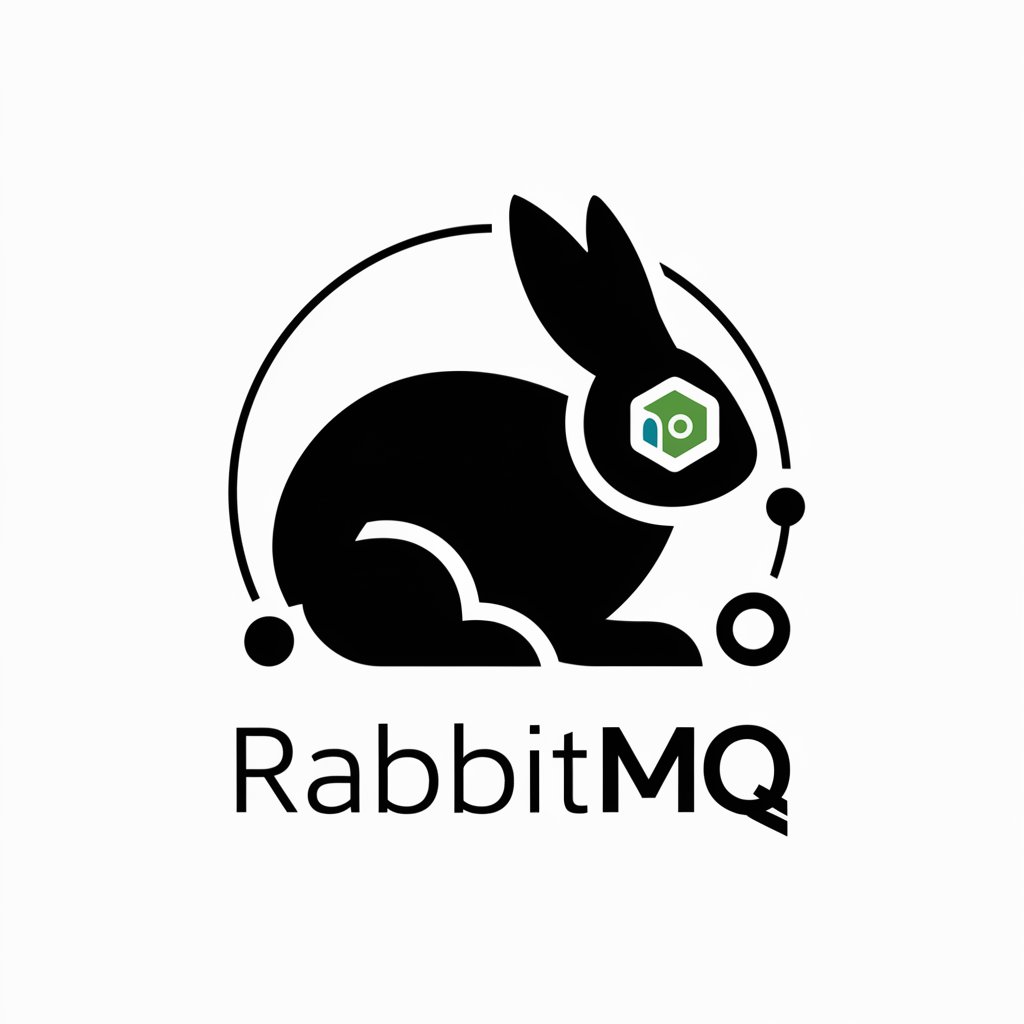RabbitMQ - Reliable Messaging Broker

Hello! Need help with RabbitMQ and NodeJS? I'm here to assist!
Empower Your Apps with AI-Driven Messaging
How can I optimize my NodeJS application for better RabbitMQ performance?
What are the best practices for using amqplib in a microservices architecture?
I'm experiencing connection issues with RabbitMQ in my NodeJS app. How can I troubleshoot this?
Can you explain how to implement a robust message retry mechanism using RabbitMQ and amqplib?
Get Embed Code
Introduction to RabbitMQ
RabbitMQ is an open-source message broker software that facilitates the efficient handling of messages between different components of an application or between different applications. It uses a variety of messaging protocols, primarily AMQP (Advanced Message Queuing Protocol), to ensure flexible communication and management of message queues. RabbitMQ acts as a middleman to store messages sent by producers until they can be processed by consumers. This decouples the production of information from its processing, enhancing scalability and reliability in distributed systems. For example, an e-commerce platform can use RabbitMQ to handle order processing: when an order is placed, it's sent to a queue where it awaits processing by a service that manages inventory and shipping. Powered by ChatGPT-4o。

Core Functions of RabbitMQ
Message Queuing
Example
Handling large volumes of messages without loss.
Scenario
In high traffic applications like social media platforms, RabbitMQ can queue messages from millions of users posting updates simultaneously, ensuring that these messages are processed sequentially and reliably without overloading the system.
Load Balancing
Example
Distributing message processing evenly across multiple consumers.
Scenario
A cloud service provider can use RabbitMQ to distribute tasks across multiple servers, balancing the load and improving the performance of applications by ensuring no single server is overwhelmed.
Asynchronous Processing
Example
Decoupling application components to enhance performance.
Scenario
In financial services, RabbitMQ allows for the asynchronous processing of transactions. It queues transactions made during the day and processes them at off-peak times, reducing the immediate workload on the system and smoothing out the peaks in transaction processing demands.
Routing and Filtering
Example
Directing messages to specific consumers based on rules.
Scenario
An IoT application uses RabbitMQ to route data from various sensors (temperature, motion) to appropriate processing services. For instance, temperature data might be sent to a climate control service, while motion data could trigger security alerts.
Ideal Users of RabbitMQ Services
Software Developers
Developers building distributed systems or microservices architectures can leverage RabbitMQ to decouple service dependencies, scale applications seamlessly, and manage asynchronous data flows effectively.
System Architects
Architects designing scalable and resilient systems find RabbitMQ essential for creating robust messaging solutions that ensure reliable data flow across different parts of the system, even under high loads.
DevOps Teams
DevOps teams can use RabbitMQ to orchestrate workflows and manage inter-service communication in continuous integration and delivery pipelines, facilitating smoother and more reliable deployments.
Enterprise IT
Large enterprises that need to integrate legacy systems with newer applications often use RabbitMQ to enable secure, reliable interconnectivity and to modernize their IT infrastructure without extensive rewrites.

Guidelines for Using RabbitMQ
Start with a Free Trial
Visit yeschat.ai to explore RabbitMQ through a no-cost, no-login trial.
Install and Configure
Install RabbitMQ server on your system. Configure it according to your operational requirements, ensuring that it matches your network and security settings.
Define Messaging Architecture
Design your messaging architecture, considering how to structure your queues, exchanges, and bindings based on your application’s communication patterns and scaling needs.
Implement in Application
Utilize libraries like amqplib in NodeJS to connect and interact with RabbitMQ. Implement message producers and consumers according to the architecture planned.
Monitor and Optimize
Monitor RabbitMQ’s performance and optimize its throughput settings, queues, and message handling strategies to enhance stability and efficiency.
Try other advanced and practical GPTs
Landing page analyzer - Official
AI-Powered Landing Page Insight

Career Coach
Empowering Your Career Journey

FRtoENorEntoFR
AI-powered, fluent bilingual translations

SEO Copy Blog | Your Optimized Article Writer
AI-powered tool for SEO-optimized articles.

JTBD Creator
Decipher User Needs with AI

Football Match Predictor: Betting Tips
AI-Powered Betting Tips & Predictions

Dizionario di Informatica per Bambini
Simplifying tech terms with AI

LinkedIn Recommendation Assistant
AI-powered recommendations that impress.

Produkttexte SEO optimiert
Empowering SEO Through AI

GPT Fishing Spot Analyzer
Cast smarter with AI-powered fishing insights.

Sale Spotter
Empower your shopping with AI-driven deals

TaxoBot
Your AI-powered Tax Expert

Frequently Asked Questions about RabbitMQ
What are the key features of RabbitMQ?
RabbitMQ offers reliable messaging for applications with features like message queuing, routing, persistence, and high availability. Its support for multiple messaging protocols, flexible routing capabilities, and strong cluster support distinguishes it from other message brokers.
How does RabbitMQ handle message persistence?
RabbitMQ can persist messages to disk to ensure they are not lost in the event of a failure. This is configurable on a per-message basis using the 'persistent' message property, which can be set when publishing a message.
Can RabbitMQ be used in a microservices architecture?
Yes, RabbitMQ is highly effective in microservices architectures for decoupling service components, distributing messages efficiently, and handling asynchronous communication patterns among services.
What is the role of exchanges and queues in RabbitMQ?
Exchanges receive messages and route them to one or more queues based on routing rules defined by bindings. Queues store messages until they can be processed by consuming applications. This separation allows for highly customizable message distribution workflows.
How does RabbitMQ ensure message delivery in case of network failures?
RabbitMQ supports message acknowledgments and transactional channels to ensure messages are not lost during network failures. Messages can be requeued or retransmitted based on the acknowledgment status from the consumer.
